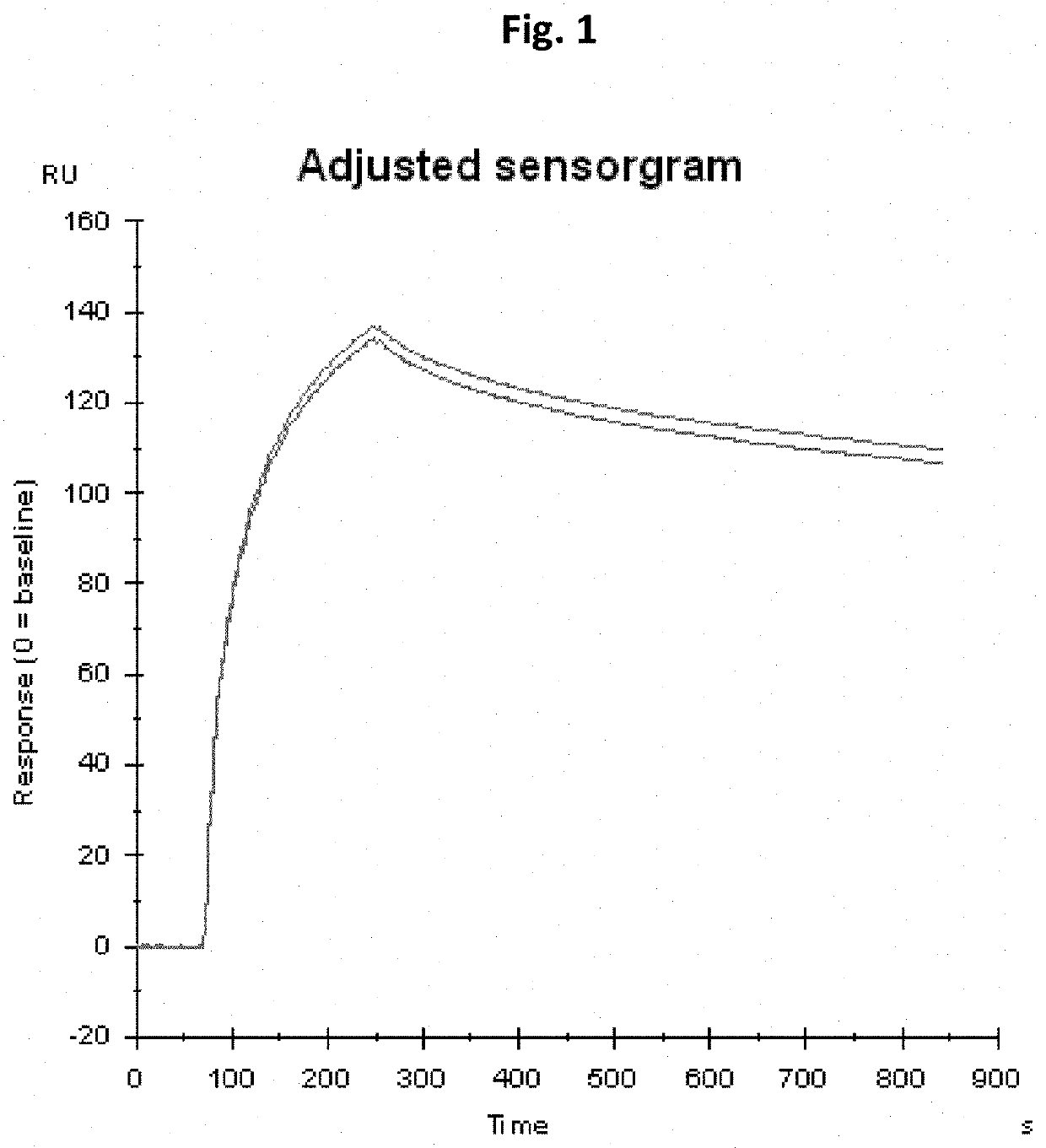Novel tnfr agonists and uses thereof
a technology of tnfr and agonist, which is applied in the field of new tnfr agonists, can solve the problems that the generation of pharmacologically active agonists has been difficult to date, and the removal of one or more checkpoint inhibitors is not sufficient to promote tumor regression in a majority of patients, so as to reduce potential steric hindrance
- Summary
- Abstract
- Description
- Claims
- Application Information
AI Technical Summary
Benefits of technology
Problems solved by technology
Method used
Image
Examples
example 2
[0131]Cloning and Sequencing of the VH and VL Chains of the Anti-OX40 Antibodies from Hybridoma Cells
[0132]For each positively selected hybridoma, total RNA was prepared, reverse-transcribed into cDNA and VH and VL genes were respectively amplified by PCR. These PCR products were ligated into a rescue-vector (pDrive vector; QIAGEN AG, Hombrechtikon, Switzerland; Cat. No. 231124), allowing for the DNA sequencing of individual PCR products and the determination of mono- or poly-clonality of the selected hybridomas. This vector allowed for blue / white selection on LB-agar plates containing IPTG and X-gal (colonies with no insert were blue because of the degradation of X-gal by the LacZ α-peptide). Recombinant plasmids from positive (white) bacterial clones were prepared and sequenced using standard DNA sequencing primers specific for the vector backbone (M13rev, M13fwd, T7 or SP6). DNA sequences were finally subcloned into an expression vector for recombinant expression of the antibody ...
example 3
Biological Characterization of Anti-Human OX40 Antibodies
OX40-Specific Antibody Detection ELISA
[0147]Antibody titers, specificity and production by hybridomas and recombinant antibody candidates were determined by a direct ELISA. In brief, 96 well-microtiter plates (Costar USA, distributor VWR AG, Nyon, Switzerland) were coated with 100 μl of recombinant human OX40-his at 2 μg / ml in PBS (see example 1 for the generation of the OX40-his protein). Plates were incubated overnight at 4° C. and were then blocked with PBS 2% BSA (Bovine Serum Albumine, PAA Laboratories, Pasching, Austria) at room temperature (RT) for one hour. The blocking solution was removed and the hybridoma supernatants or purified antibodies were added. The plates were incubated at RT for 30 minutes, then washed nine times with PBS 0.01% Tween-20 (Sigma-Aldrich Chemie GmbH, Buchs, Switzerland) and a Horseradish Peroxidase (HRP) labeled-Goat anti-mouse H+L-detection antibody (Sigma-Aldrich Chemie GmbH, Buchs, Switzerl...
example 4
ION AND OPTIMIZATION OF MOUSE 7H11 ANTIBODY
[0148]Humanizing the anti-human OX40 mouse antibody 7H11 including selection of human acceptor frameworks, back mutations, and mutations that substantially retain and / or improve the binding and properties of human CDR-grafted acceptor frameworks while removing potential post-translational modifications is described herein. The mouse 7H11 antibody has variable heavy chain domain sequence set forth in SEQ ID NO: 2 and variable light chain domain sequence set forth in SEQ ID NO: 3.
Methods
Recombinant Production of Antibodies
[0149]Coding DNA sequences (cDNAs) for the different VH and VL domains were synthesized in a scFv format by GENEART AG (Regensburg, Germany) thereby allowing for a single DNA sequence to encompass both variable domains. Individual variable domain cDNAs were retrieved from this scFv construct by PCR, and further assembled upstream of their respective constant domain cDNA sequence(s) using PCR assembly techniques. Finally, the...
PUM
| Property | Measurement | Unit |
|---|---|---|
| dissociation constant | aaaaa | aaaaa |
| dissociation constant | aaaaa | aaaaa |
| volume | aaaaa | aaaaa |
Abstract
Description
Claims
Application Information
 Login to View More
Login to View More - R&D
- Intellectual Property
- Life Sciences
- Materials
- Tech Scout
- Unparalleled Data Quality
- Higher Quality Content
- 60% Fewer Hallucinations
Browse by: Latest US Patents, China's latest patents, Technical Efficacy Thesaurus, Application Domain, Technology Topic, Popular Technical Reports.
© 2025 PatSnap. All rights reserved.Legal|Privacy policy|Modern Slavery Act Transparency Statement|Sitemap|About US| Contact US: help@patsnap.com



